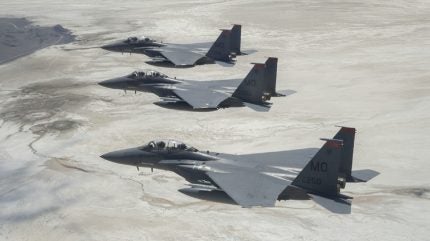
The US Air Force has completed the Initial Operational Test and Evaluation phase of the Eagle Passive Active Warning Survivability System (EPAWSS).
This digital ‘system of systems’, manufactured by BAE Systems, provides a range of electronic warfare (EW) capabilities to the F-15E Strike Eagle and F-15EX Eagle II multi-role fighter jets to combat airborne and surface threats. There are 220 F-15Es in service worldwide.
Such capabilities include radar warning, geolocation, situational awareness and self-protection. EPAWSS allows freedom of manoeuvre while its radio frequency (RF) electronic countermeasures (ECM) enable deeper penetration against modern integrated air defence systems.
Penterating modern air defences
It is worth noting that air defence systems remain a high priority when Western nations consult Ukraine on their most pressing requirements, which demonstrates the impact these systems can have in countering Russian aerial presence.
Furthermore, in the Baltic sphere, Lithuania has pressed its Nato allies to send a rotational integrated air and missile defence model to the country – a significant pledge given to the nation at the Vilnius summit last July.
GlobalData intelligence forecasts a compound annual growth rate of 4.6% in the EW market over the next ten years to overcome such a solid air defence build-up. The market is expected to grow from $13.9bn last year to $21.8bn in 2033.
How well do you really know your competitors?
Access the most comprehensive Company Profiles on the market, powered by GlobalData. Save hours of research. Gain competitive edge.

Thank you!
Your download email will arrive shortly
Not ready to buy yet? Download a free sample
We are confident about the unique quality of our Company Profiles. However, we want you to make the most beneficial decision for your business, so we offer a free sample that you can download by submitting the below form
By GlobalDataNotably, 55.1% of the EW market share will focus on airborne systems such as the EPAWSS, which is designed to enhance aerial supremacy.
Upgradability – F-35 faces enduring modernisation delays
“EPAWSS was designed for upgradeability and rapid capability insertion,” the programme manager at BAE Systems, Amy Nesbitt, stated. “We’re using agile software development to provide iterative upgrades to fielded EW systems – allowing our customers to defeat future electromagnetic threats.”
The Eagle system will benefit from a proactive approach to maintainability as the rapid capability insertion will extend the service life of the fighter’s EW network and also reduce lifecycle costs.
Currently, the F-35 Lightning II is undergoing enduring modernisation delays as the US Department of Defense (DoD) has yet to implement Block 4 upgrades that will allow the world’s most sophisticated fighter to meet new threats.
These Block 4 capabilities require more power and cooling than anticipated, which has prompted the DoD to modernise the overworked F135 engine.
The US Government Accountability Office has repeatedly voiced concern, and in two reports last year provided recommendations for the DoD to address its delay.
Originally due to be completed in 2026 and determined to cost $10.6bn, the Block 4 programme has risen to $16.5bn and is now estimated to conclude in 2029.
Integrating the EPAWSS into F-15Es will help to alleviate this potential issue that the F-35 currently faces.






